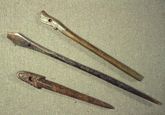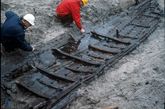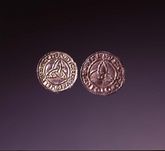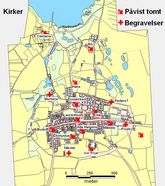The landing place was established on a beach ridge, and in front of it was a wide, habitable salt marsh. Excavations in this area have demonstrated the production of bone and antler combs, the presence of a bronze caster and a blacksmith as well as fishermen's tools. There is not much evidence for trade, but connections with Norway or Western Sweden and the Baltic areas of present-day Northeastern Germany and Poland were traced. No wharfs or other constructions for ships, lying at anchor have been found. Excavations in the harbour area have revealed nine ship wrecks. Of these, a war ship has been dendrochronologically dated to some time after AD 1025 whereas a cargo vessel has been dendrochronologically dated to around AD 1060. Another four wrecks have been dendrochronologically dated to the 12th century while a further three wrecks date from the 13th and 14th centuries.
Throughout the Middle Ages, Roskilde maintained its position among Denmark's most important towns due to its royal seat, its mint, an extraordinarily wealthy Episcopal residence and many clerical institutions. However, the beginning of the 15th century heralded new and less favourable times. In AD 1416 the King forced the Bishop of Roskilde to surrender the wealthy commercial town of Copenhagen which was soon to become the most important town in the country as a residence for the King and his court. Following the Reformation in AD 1536 a great part of Roskilde’s economic base disappeared with the demise of the Episcopal institutions, together with their riches and their demand for goods and services. Only the Cathedral, Church of Our Lady, St. James' Church and St. Jørgensbjerg Church avoided demolition, whereas the other parish churches fell into disrepair and were demolished during the 16th and 17th centuries at the latest. At the same time, the town’s harbour was no longer attractive to the deep-draughted merchant ships of this period. Roskilde's merchants and craftsmen were badly afflicted. Whole quarters were abandoned and laid out as gardens, enclosed fields and grazing for the townsmen's livestock.
Jens Ulriksen, Roskilde Museum
Roskilde
During the first half of the 11th century Roskilde sprang up on an open field and in the course of a few years became the mightiest town in the kingdom – the domicile of both King and Bishop.
Roskilde was apparently founded on virtually virgin soil as a demonstration of the power of the new Christian kingdom and its new ally: the Church. Roskilde Museum has carried out more than 130 archaeological excavations in the town over the past 30 years. These demonstrate that Roskilde was founded around AD 1000.
Several written sources from the 11th century clearly document that Roskilde was the domicile of both the Bishop and the King by the AD 1120s at the latest. Around AD 1070 the German clergyman Adam of Bremen wrote that "the greatest town is Roskilde – the Danish royal residence".
Fact: From the 5th century onwards, the area around Roskilde became the domicile of a chieftain lineage that lived at Lejre, about 10 km west of Roskilde, for the next 600 years. According to legend, Lejre was handed over as a royal seat and a heathen sacrificial site. Archaeological investigations have demonstrated that, throughout Late Germanic and Viking times, the area was inhabited by the absolute elite. Following the conversion to Christianity, and the centralisation of Denmark towards the end of the 10th century, Lejre evidently lost its position of power and status in favour of Roskilde.
Roskilde belongs to a particular type of town that came into existence in Denmark in the decades around 1000 AD. Relative to the Viking commercial centres such as Haithabu and Birka, Roskilde was established as an unfortified and much more open settlement. The town centre was situated high above the fjord, with the cathedral occupying a prominent position. Below the hill was the town’s landing place, Vindeboder, from the 11th-12th centuries, as well as the settlement associated with the church of St. Clement's (now St. Jørgensbjerg) on the western side of the bay.
The first king with a definite connection to Roskilde was Cnut the Great. He minted coins here. Roskilde was the residence of the King’s earl, Ulf, who was married to the King’s sister, Estrid. Ulf and Estrid were also foster parents for Cnut’s son, Harthacnut. A conflict between the King and the earl resulted in Ulf being killed by the King’s men in about AD 1026. However, Ulf’s own son, Svein Estridsson, became King of Denmark from AD 1047 to 1074.
Archaeological investigations have revealed settlement traces within an area of 800 x 1100 m, partly in the form of culture layers, refuse pits, ditches, fences and postholes, together with a single house site, and partly in the form of churches. Roskilde’s overall street plan already seems to have been staked out from the very beginning. There were thoroughfares running between the town centre and the harbour, and the medieval main street, which ran east-west, included the town’s 400 m long market street; this extended from St. Lawrence’s Church in the west to St. Michael’s Churchyard in the east. Archaeological excavations near St. Lawrence Church suggest that before the erection of the stone church at the beginning of the 12th century there was a small wooden church here as well as a marketplace. A fence was found, which is interpreted as marking a boundary between marketplace and churchyard. A huge post, which was surrounded by a plank fence measuring 1.75 x 1.50 m and older than the travertine church, is thought to constitute the remains of a market cross.
Literature
In Danish
Adam af Bremen: De hamburgske Ærkebispers Historie. Oversat af Carsten L. Henrichsen. 1930.
Birkebæk & Høj: Roskilde bys historie - tiden indtil 1536. 1992.
Christensen: Lejre - Syn og sagn. 1991.
Christensen & Andersen (red.): Civitas Roscald – fra byens begyndelse. 2000.
Roskildekrøniken. Oversat af Michael H. Gelting. 1979.
Ulriksen: Roskilde i 11.-12. årh. I: H. Andersson et al. (red): De to første hundrede årene. Artikelsamling fra arbejdsseminar i Bergen, 10.-15. oktober 2006. (i tryk).



